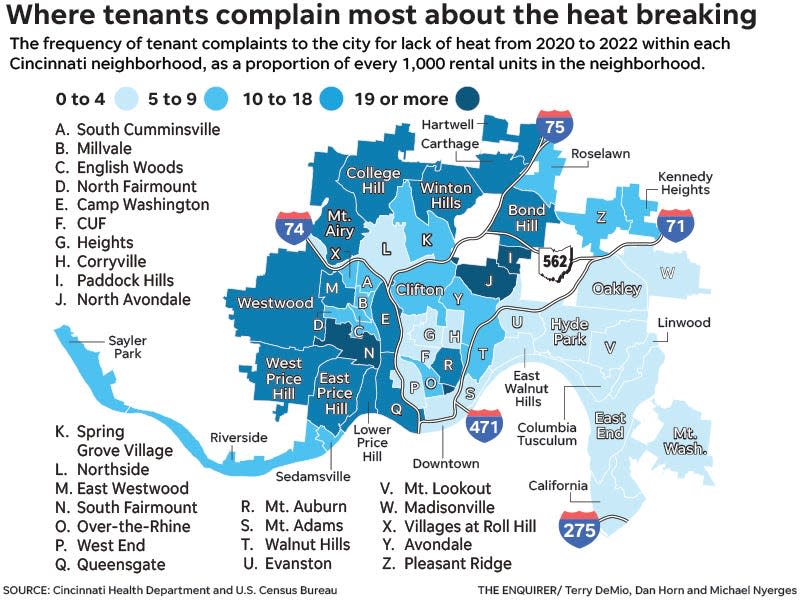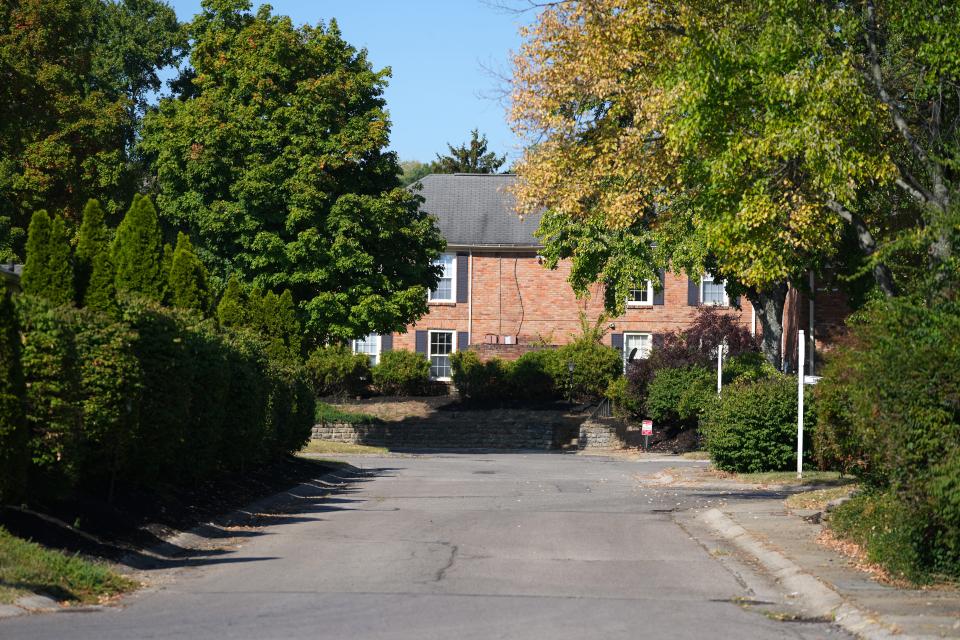Cincinnati landlords must provide heat to renters. What happens if they don't?
Landon Pickett woke up to 51 degrees. In his bedroom.
It was late November during the first winter that Pickett lived with his girlfriend in their rental home in East Price Hill. The heat was set at 65 degrees, and he heard the furnace running, but it was blowing cold air.
So the 28-year-old union electrician and his girlfriend, 22-year-old dental assistant Journi Boone, called the property manager for their unit, owned by a company that city rental records say is based in New York, to get the furnace fixed.
Can't get the landlord to fix the heat? Cincinnati health department will help
Waiting to hear back, they bundled in layers and huddled in the bedroom because it was the warmest place in the house. When that got too cold, they went to a hotel. To make their home life more comfortable, Pickett bought three space heaters.
They still didn’t get a response.
Landlords in Cincinnati are supposed to provide in their rental properties a minimum temperature of 70 degrees when the outside temperatures drop below 60 for more than 24 hours, but an Enquirer investigation found that some fail to provide adequate heat, leaving tenants like Pickett to fix the problems out of their own pockets or simply live with it.
Cincinnati’s health department asks renters to speak to landlords and property managers directly about the problem before filing complaints so there's no way to know how many people struggle with insufficient heat. The health department only knows about the complaints it receives, said Environmental Health Director Antonio Young. The department receives a steady stream of complaints every winter. And even when city inspectors take over the cases, they, too, at times struggle to reach the people responsible for fixing the heat, leaving residents in the cold.
Some property owners said they took over properties in disrepair and fixed the problem. Others did not respond to The Enquirer’s request for comment or were unable to be reached.
Tenants’ complaints are usually simple.
“Insufficient heat due to a hole in the ceiling letting in cold air,” one caller said Feb. 2, 2021. “Landlord has not turned on the heat in the building,” another said in a message on Oct. 25, 2021.
“No heat for two weeks,” said one tenant in a complaint Dec. 27, 2022, with the health department adding, “tenant reports staying in a hotel at her own expense because she has no heat."

Hundreds of complaints filed against Cincinnati landlords
The health department's Healthy Homes specialists investigate the complaints of noncompliance with the health code, going to apartments and rental homes with thermometers in hand to check for problems. They can cite landlords for failing to heed the code.
In 2022, the health department received 372 complaints from tenants for inadequate or no heat. The time period included pre-Christmas weather with temperatures across Ohio below zero. That led to a jump in complaints from 184 in 2021 and 145 in 2020.
Five owners had the most complaints from 2020 to 2022, the latest years that the information was available, according to an Enquirer analysis:
Cincinnati Metropolitan Housing Authority.
RRE Williamsburg Holdings.
Cincinnati Portfolio Realty.
H&E Enterprise.
Pendleton Housing Partners.
SFR3, the landlord for Pickett's home, had just one complaint to the health department in the three-year review period, records show.
The neighborhoods with the most complaints, compared to how many rental units are in each, are:
North Avondale and Paddock Hills, with 35 per 1,000 rental units.
South Fairmount with 28 per 1,000 rental units.
Pendleton, with 26 per 1,000 rental units.

To account for the difference in the number of rental properties in a neighborhood, The Enquirer did a per capita analysis of heat complaints for each neighborhood.
Cincinnati’s West Side neighborhoods bore the brunt of the heat complaints.
Westwood, East Westwood, South Fairmount, West Price Hill, East Price Hill are clustered together, all with 10 to more than 19 complaints to the health department for every 1,000 rental units in the neighborhood.
The East Side of Cincinnati had pockets in which there was a high volume of complaints, too, but overall, the West Side had more. The swath of neighborhoods including Oakley, Hyde Park, East End and Mount Washington had anywhere from no complaints to four per 1,000 rental units.
Heat problems affect Cincinnati's poorer neighborhoods
Overall, at least 1 in 4 residents living in five of the 10 neighborhoods with the highest proportion of heat complaints lives below the poverty line, which was $25,750 in annual income for a family of four in Ohio, according to 2019 data from the U.S. Census Bureau. The city has a lot of rental properties overall, with renters accounting for 62% of all Cincinnati households.
In South Fairmount, nearly half the residents live in poverty. Also within the top 10 neighborhoods per occupied rental unit were Lower Price Hill and Queensgate, combined – where nearly 4 in 5 residents live in poverty. East Price Hill, where Pickett and Boone live, has a poverty rate of nearly 2 in 5 and ranked No. 13 out of 42 neighborhoods, with 10 complaints over the time period per 1,000 rental units.
Residents in more affluent neighborhoods were less likely to complain about lack of heat. Out of four neighborhoods with no complaints over the three-year period, three had low poverty levels: California (0.7%), East End (19.2%), and Mt. Lookout/Columbia Tusculum (3.1%).
Living without adequate heat can lead to a higher risk for catching viruses, Young said. Colder temperatures over a sustained period can also exacerbate existing health problems, he said. The struggle is compounded for people who live in poverty, because they already have less access to medical care and are at higher risk for health issues.
Cincinnati Health Department tried to find Pickett’s landlord
Pickett called the Cincinnati Health Department’s phone number for tenant complaints on Dec. 1, records show. An environmental health investigator came to his Purcell Avenue home Dec. 5 and took temperatures.
"Heat was temped at 57 degrees downstairs with a heater and 62 degrees upstairs with heaters," health specialist Brynn Hounshell wrote in a report. "Unsanitary conditions exist due to no heat in the unit and the potential for illness associated with such conditions."
Hounshell tried five email addresses and called five numbers to try to locate a responsible property manager or the landlord, SFR3, to notify them they must comply with the city's healthy heat code, her report shows.
“There has been no contact from the owner or mgmt. group to the tenants and there still is no heat,” Hounshell wrote in the case report on Dec. 6. “No one even dropped off extra space heaters from the unit.”
On Dec. 8, Hounshell reported that a city law department attorney had emailed owners and management partners "to solve who is responsible for violations, with an unsuccessful attempt."
Pickett stayed in the home and kept using the space heaters he had purchased.
Where's the landlord? It's not always clear
When the health department seeks to solve the problem for the tenants, city inspectors at times struggle to reach those responsible for fixing the heat. That’s partly because so many of the properties are owned by firms with little public-facing information.
Young said the investigators find email and phone contacts for landlords and rental managers through city resources including rental registration records, the auditor’s office and other city agencies that encounter property owners. “It still can be challenging to contact owners at times,” Young said.
The Enquirer also had trouble reaching landlords for comment on this story.
A reporter reached out to Pickett’s landlord, SFR3, by emailing and calling “emergency” and “primary” contacts listed on city records. Attempts to reach owners or representatives gathered from online searches of states' business registries were also unsuccessful. One individual whose number was listed online as a representative answered a call but said they were not involved in the business. A website for a company called SFR3 offers information about its "affordable homes for America" but it does not list a phone contact, only a generic form.
A reporter also was unable to reach BRC (formerly RRE) Williamsburg Holdings representatives, despite multiple attempts. John Rothschild, who took control of the property as a court-ordered receiver, did not return phone or email messages.
The same pattern followed with H&E Enterprise, a property owner that was identified in 11 tenants’ no-heat complaints in the period. And in another case where 11 complaints were filed, that of Cincinnati Portfolio Realty, the online listing of a representative – who did not return a phone call – was more than 10 years old.
But some representatives did return calls for comment. Among them was Cincinnati Metropolitan Housing Authority, which oversees public housing in the Cincinnati area.
“Cincinnati Metropolitan Housing Authority is the owner and manager of over 4,000 rental units across Hamilton County with an age averaging over 70 years,” the housing authority said in a statement provided by spokeswoman Lesley Wardlow. “CMHA takes the health and safety of the residents seriously and works effortlessly to prevent issues from arising and address those that do occur.”
The housing authority said property owners involved in its Housing Choice Voucher program, which supplements rents for low to moderate income families, must provide adequate heat. When the housing authority learns of a lack of or inadequate heat at one of the rental properties, CMHA inspects and orders the owner to fix the problem. If they fail to do so, the family living in the home is given a moving voucher.
Fines helped Pickett get his heat back, but not for long
Hounshell, the health inspector on Pickett’s case, issued a citation to SFR3 on Dec. 6 for $300. On Dec. 7, she fined them $750. Her notes said the issue was “defective furnace, no heat throughout the house.”
City records show fines of $300 and $750 were paid, and on Dec. 11, Pickett called the health investigator to say the heat seemed to be back on.
It didn’t last.
Pickett said the furnace worked through most of December but went out three or four days over the New Year’s Day weekend. A maintenance person then came Jan. 2 and fixed the furnace, he said.
Some property owners have been sued for similar issues. Others say they’re trying
While some of the landlords with a high number of heat complaints are already facing legal challenges from the city for violating city codes related to cold weather, another said the complaints are a reflection on the age and quantity of their properties.
BRC Williamsburg Holdings, formerly RRE Williamsburg Holdings, was named in a city nuisance lawsuit in Hamilton County Common Pleas Court.

The city’s complaint, filed in January 2023 against the owner of the 976-unit Williamsburg Apartments complex in Hartwell, claimed the rental units were “unlivable.” The suit says residents were forced from their apartments in December 2022 after living without water or heat or in units that were flooded after pipes burst due to the cold. The lawsuit listed problems including water damage, mold, hazardous wiring and blocked sewer lines. The court case remains open.
And in another BRC Williamsburg Holdings-related case, Boruch “Barry” Drillman, manager, pleaded guilty in federal court in December 2023 to mortgage fraud schemes.
The city sued H&E Enterprise for negligence in January 2023. Avi Ohad, listed as a registered agent and named as an owner of the limited liability company, the same month was convicted of negligence in Hamilton County Municipal Court and sentenced to probation over a building code violation – failing to provide heat in December 2022.
In a sworn statement in court, Laura Kamphaus, of Cincinnati Building and Inspections, said Ohad was in control of a Ross Avenue property and failed to comply with orders issued Jan. 13, 2022, to restore heat to there by Feb. 14.
Pendleton Housing Partners LP, which accumulated eight complaints over the review period, said it fixed the properties since purchasing rental units that were in disrepair. The landlord inherited problem properties, said Scott Muioio, director of asset management for the Vitus Group of Seattle, a general partner and decision-maker for Pendleton Housing Partners.
Records show that the business took over the properties from a previous owner on Aug. 21, 2021. Muioio said the new owners completed an $8 million rehab of the property in December 2022.
“It was an aging property,” Muioio said. “A lot of the complaints happened before we purchased the property.”
Pickett wearies of the struggle, keeps space heaters on
Pickett contacted The Enquirer on Jan. 14 to say the heat was out again. That day, the low temperature in Cincinnati was 8 degrees. The high was 24.
"Hi, we are still at the house,” Pickett wrote in a text the next day. "The heat is still not functioning properly and our cold water and overall water pressure is very low. It has not risen above 52."
The temperatures for that day, Jan. 15, ranged from 4 to 14 degrees outside.
The city transferred Pickett's complaints to the Cincinnati Buildings and Inspections Department. On Feb. 1, Pickett said the heat returned.
This article originally appeared on Cincinnati Enquirer: Cincinnati renters file hundreds of complaints over heat regulations

